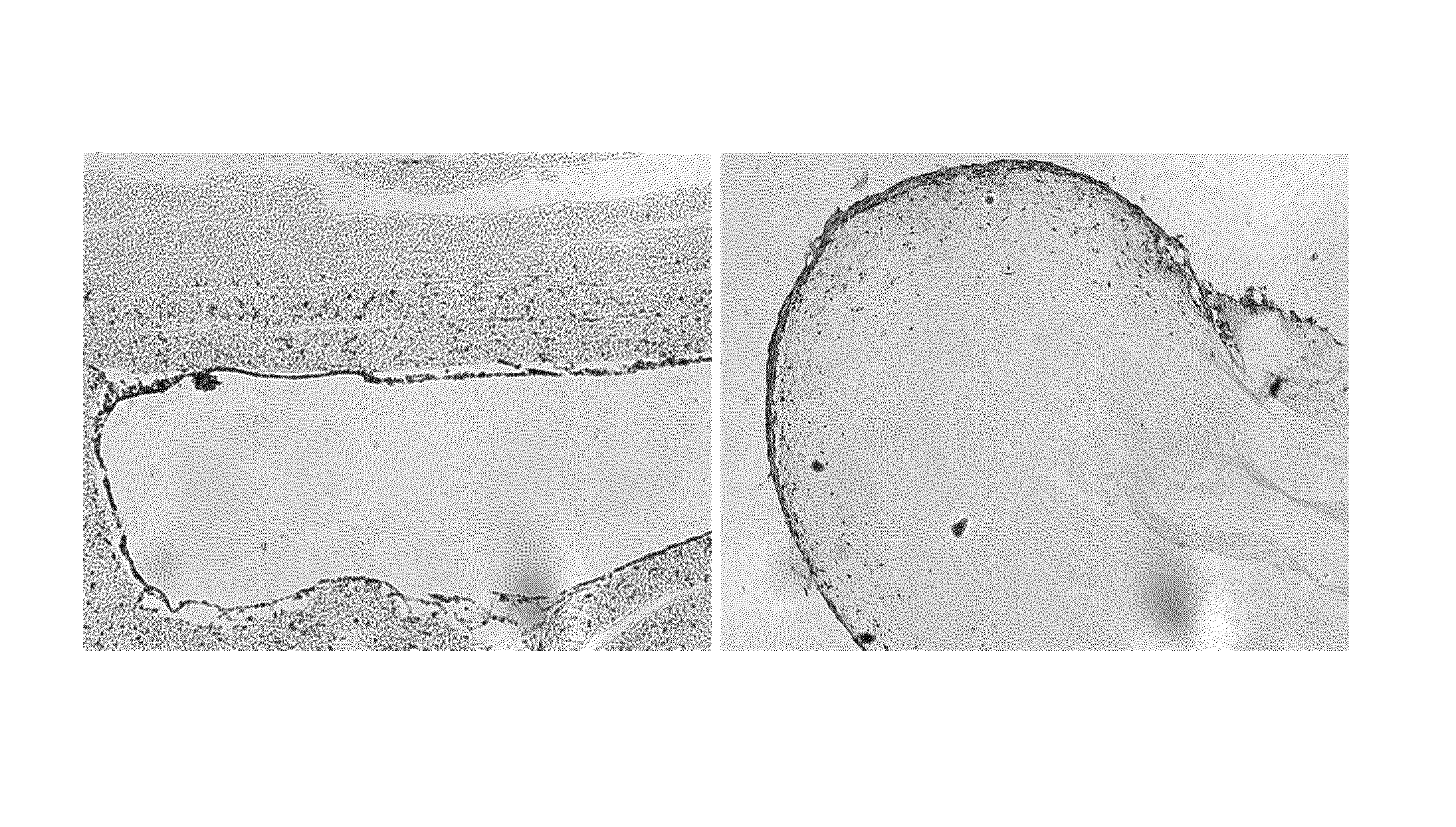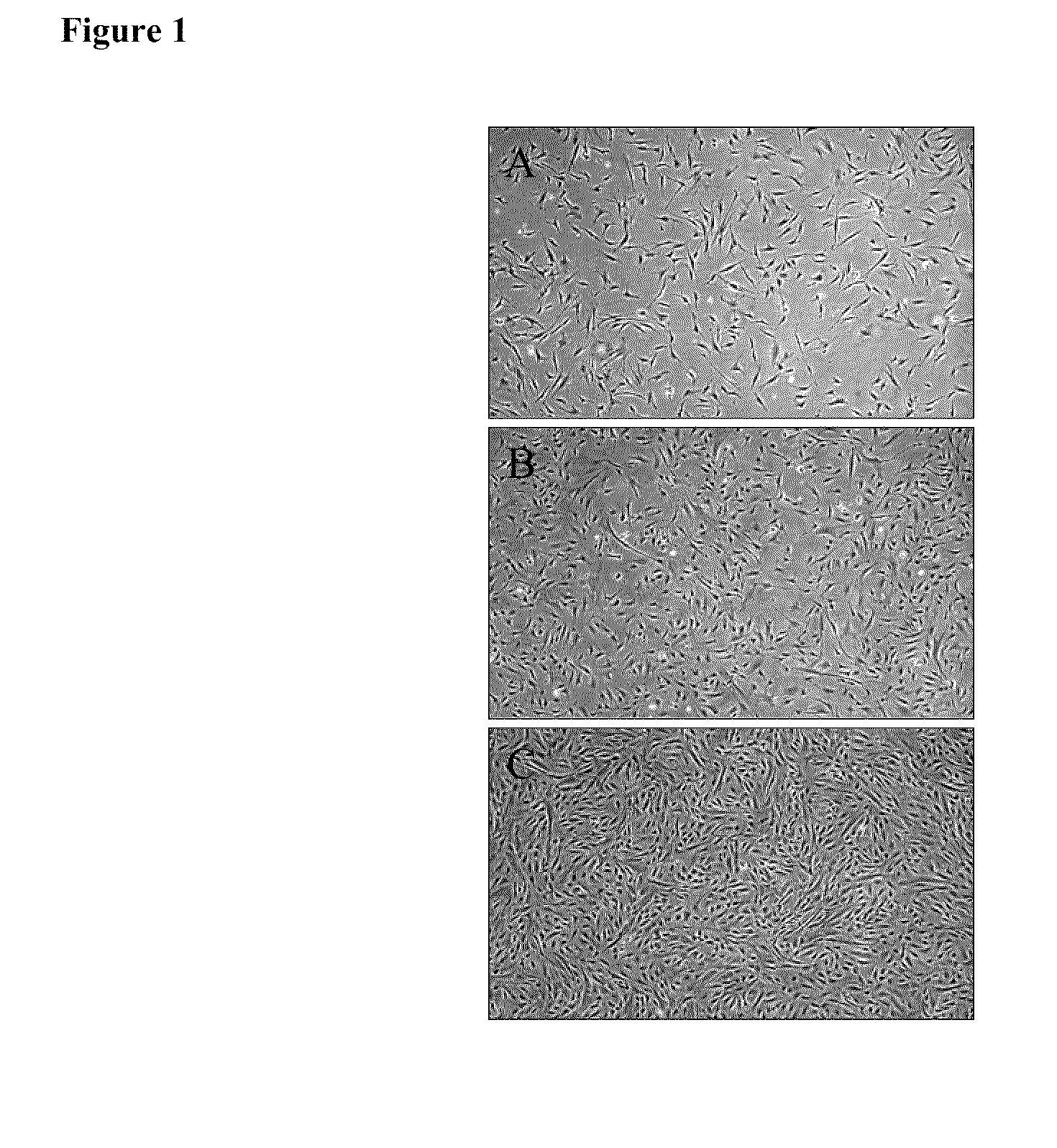Mammary artery derived cells and methods of use in tissue repair and regeneration
a technology of mammary arteries and derived cells, which is applied in the field of mammalian mammary arteries, can solve the problems of systolic hypertension, coronary insufficiency, ischemia, and congestive heart failure, and achieves the effects of reducing the risk of stroke, and improving the survival ra
- Summary
- Abstract
- Description
- Claims
- Application Information
AI Technical Summary
Benefits of technology
Problems solved by technology
Method used
Image
Examples
example 1
Cell Isolation Optimization
[0042]Initial experiments were conducted to determine the optimal time necessary for tissue digestion. A five centimeter portion of the human internal mammary artery was obtained from the National Disease Research Interchange (NDR1, Philadelphia, Pa.). The artery was trimmed and washed in Dulbecco's modified Eagles medium (DMEM-low glucose; Invitrogen Corporation, Carlsbad, Calif.) or phosphate buffered saline (PBS; Invitrogen Corporation, Carlsbad, Calif.) to remove blood and debris. The entire artery was then transferred to a 50-milliliter conical tube.
[0043]The tissue was then digested, for varying amounts of time in an enzyme mixture containing 0.25 Units / milliliter collagenase (Serva Electrophoresis GmbH, Heidelberg, Germany) and 2.5 Units / milliliter dispase (Roche Diagnostics Corporation, Indianapolis Ind.). The enzyme mixture was then combined with endothelial growth medium-2 (EGM-2) (Lonza, Walkersville, Md.). The conical tube containing the tissue...
example 2
Isolation of Human Internal Mammary Artery-Derived Cells
[0045]The optimal digestion time interval (described in Example 1) was then applied to isolate internal mammary artery-derived cells. A five centimeter portion of the human internal mammary artery was obtained from the National Disease Research Interchange (NDR1, Philadelphia, Pa.). The artery was trimmed and washed in Dulbecco's modified Eagles medium (DMEM-low glucose; Invitrogen Corporation, Carlsbad, Calif.) or phosphate buffered saline (PBS; Invitrogen Corporation) to remove blood and debris. The entire artery was then transferred to a 50-milliliter conical tube.
[0046]The tissue was then digested in an enzyme mixture containing 0.25 Units / milliliter collagenase (Serva Electrophoresis GmbH, Heidelberg, Germany) and 2.5 Units / milliliter dispase (Roche Diagnostics Corporation, Indianapolis, Ind.). The enzyme mixture was then combined with iMAC Growth Medium (a basal medium with reduced fetal serum albumin sold under the trade...
example 3
Human Internal Mammary Artery-Derived Cell Morphology
[0047]Fresh iMACs, isolated as described in Example 2, were plated at 5000 cells / cm2 onto type I rat tail collagen coated T75 flasks in iMAC Growth Medium and cultured at 37° C. in 5% carbon dioxide. Cells were passaged every 3-5 days. At each passage, cells were harvested with TRYPLE Select (1×) trypsin replacement (Invitrogen Corporation, Carlsbad, Calif.), counted and viability was measured using a GUAVA flow cytometry instrument (Guava Technologies, Hayward, Calif.). For morphological evaluation, iMACs were assessed by light microscopy and morphological characteristics of the cells were observed using a Nikon microscope and LCD digital camera.
[0048]iMACs were assessed by light microscopy and morphological characteristics of the cells were observed using a microscope (Nikon Eclipse TE2000-U, Nikon Instruments, Inc., Melville, N.Y.) and LCD digital camera (FIG. 1). Consistently, cultures of iMACs showed a fibroblastic morphology...
PUM
| Property | Measurement | Unit |
|---|---|---|
| total volume | aaaaa | aaaaa |
| doubling time | aaaaa | aaaaa |
| voltage | aaaaa | aaaaa |
Abstract
Description
Claims
Application Information
 Login to View More
Login to View More - R&D
- Intellectual Property
- Life Sciences
- Materials
- Tech Scout
- Unparalleled Data Quality
- Higher Quality Content
- 60% Fewer Hallucinations
Browse by: Latest US Patents, China's latest patents, Technical Efficacy Thesaurus, Application Domain, Technology Topic, Popular Technical Reports.
© 2025 PatSnap. All rights reserved.Legal|Privacy policy|Modern Slavery Act Transparency Statement|Sitemap|About US| Contact US: help@patsnap.com



